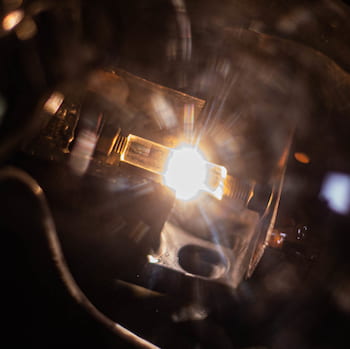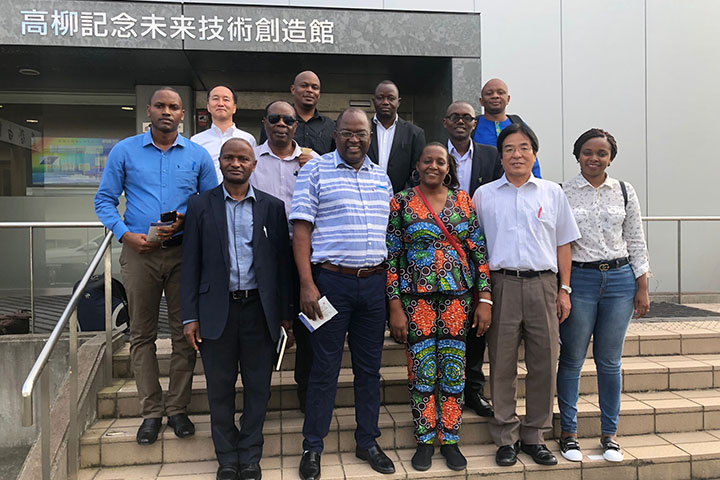(Rice lab turns trash into valuable graphene in a flash)
2020/1/27 アメリカ合衆国・ライス大学

・ライス大学が、ほぼすべての炭素源をグラフェン片に迅速かつ安価に変換する、「フラッシュ・グラフェン」技術を開発。
・従来的な方法によるグラフェン作製よりも少ないコストで、石炭、食品廃棄物、混合プラスチック廃棄物、ゴムタイヤ等をグラフェンに変換する。世界では食品の 30~40%が腐敗等の理由で廃棄されており、廃プラスチックは世界的な課題。
・同フラッシュ・グラフェンは、炭素を含有する材料を 10 ミリ秒間 3,000K(約 5,000℉)で加熱して作製。現在、グラフェンの商業価格は 1 トン当たり$67,000~$200,000 であることから、同技術は極めて有望と考える。
・コンクリートのバインドにフラッシュ・グラフェンをセメントで 0.1%でも使用すれば、コンクリートによる環境負荷を 1/3 に低減可能。グラフェンは、セメントの水和と強化を制御する、2D テンプレートと補強剤の役割を担う。
・埋立地で食品廃棄物が排出する CO2 やメタン等の温暖化ガスを捕獲し、それらをグラフェンに変換してコンクリートに添加することで、コンクリート製造における CO2 排出量を低減する、グラフェンを使用した互恵的な環境シナリオを提供する。
・今回開発したフラッシュ・グラフェン技術は、グラファイトの剥離技術や、より煩雑で高コストをかけながら、作製できるのは僅かな量のグラフェンのみという金属箔への化学蒸着(CVD)法より優れるもの。
同技術はさらに、層間の密着力が弱く、溶液中や複合材への混合で容易に剥離できる乱層構造のグラフェンを作製できる。他プロセスによる AB 積層グラフェンでは、層間の密着力が強く剥離が困難。
・コーヒーの搾りかすを高純度の単層グラフェンシートに変換できることも発見。プラスチック、金属、ベニヤ板、コンクリートや他の建材とグラフェンのバルク複合材が、フラッシュ・グラフェンの主要な市場と考える(グラフェンで強化したコンクリートとプラスチックは試験済)。
・同技術のプロセスでは、カスタム設計のリアクタで材料を急速に加熱し、非炭素元素を全てガスとして排出。同プロセスを産業規模に拡大した場合、フラッシュリアクタから排出される酸素や窒素は価値ある微小分子として捕獲できる。また、同プロセスでは、その全エネルギーを炭素材料に集中して余剰熱をほとんど出さず、CVD 炉の約 3 倍の熱を利用しながらも、数秒後リアクタに指を差し込めるほど。これは、全余剰エネルギーが光として放出されるため。
・原子レベルのシミュレーションにより、迅速なグラフェン形成の鍵が温度であることを確認。同技術は、基本的には炭素が基底状態のグラファイトから展開する緩慢な形状変化プロセスをスピードアップしたもの。熱のスパイクでプロセスが加速され、グラフェンになった段階で停止する。
・米エネルギー省(DOE)が資金を提供する、米国製石炭の変換を目指すプロジェクトを開始し、2年以内に 1 日当たり 1kg のフラッシュ・グラフェン作製する予定。スタートアップ企業の Universal Matter Ltd.とのコファンドによるフラッシュ・グラフェンプロセスのスケールアップに向けたグラントを DOE より受領している。
・本研究は、米国空軍研究所(AFOSR)および米国立科学財団(NSF)が支援した。
URL: https://news.rice.edu/2020/01/27/rice-lab-turns-trash-into-valuable-graphene-in-a-flash/
(関連情報)
Nature 掲載論文(アブストラクトのみ:全文は有料)Gram-scale bottom-up flash graphene synthesis
URL: https://www.nature.com/articles/s41586-020-1938-0
<NEDO海外技術情報より>
Abstract
Most bulk-scale graphene is produced by a top-down approach, exfoliating graphite, which often requires large amounts of solvent with high-energy mixing, shearing, sonication or electrochemical treatment1,2,3. Although chemical oxidation of graphite to graphene oxide promotes exfoliation, it requires harsh oxidants and leaves the graphene with a defective perforated structure after the subsequent reduction step3,4. Bottom-up synthesis of high-quality graphene is often restricted to ultrasmall amounts if performed by chemical vapour deposition or advanced synthetic organic methods, or it provides a defect-ridden structure if carried out in bulk solution4,5,6. Here we show that flash Joule heating of inexpensive carbon sources—such as coal, petroleum coke, biochar, carbon black, discarded food, rubber tyres and mixed plastic waste—can afford gram-scale quantities of graphene in less than one second. The product, named flash graphene (FG) after the process used to produce it, shows turbostratic arrangement (that is, little order) between the stacked graphene layers. FG synthesis uses no furnace and no solvents or reactive gases. Yields depend on the carbon content of the source; when using a high-carbon source, such as carbon black, anthracitic coal or calcined coke, yields can range from 80 to 90 per cent with carbon purity greater than 99 per cent. No purification steps are necessary. Raman spectroscopy analysis shows a low-intensity or absent D band for FG, indicating that FG has among the lowest defect concentrations reported so far for graphene, and confirms the turbostratic stacking of FG, which is clearly distinguished from turbostratic graphite. The disordered orientation of FG layers facilitates its rapid exfoliation upon mixing during composite formation. The electric energy cost for FG synthesis is only about 7.2 kilojoules per gram, which could render FG suitable for use in bulk composites of plastic, metals, plywood, concrete and other building materials.



